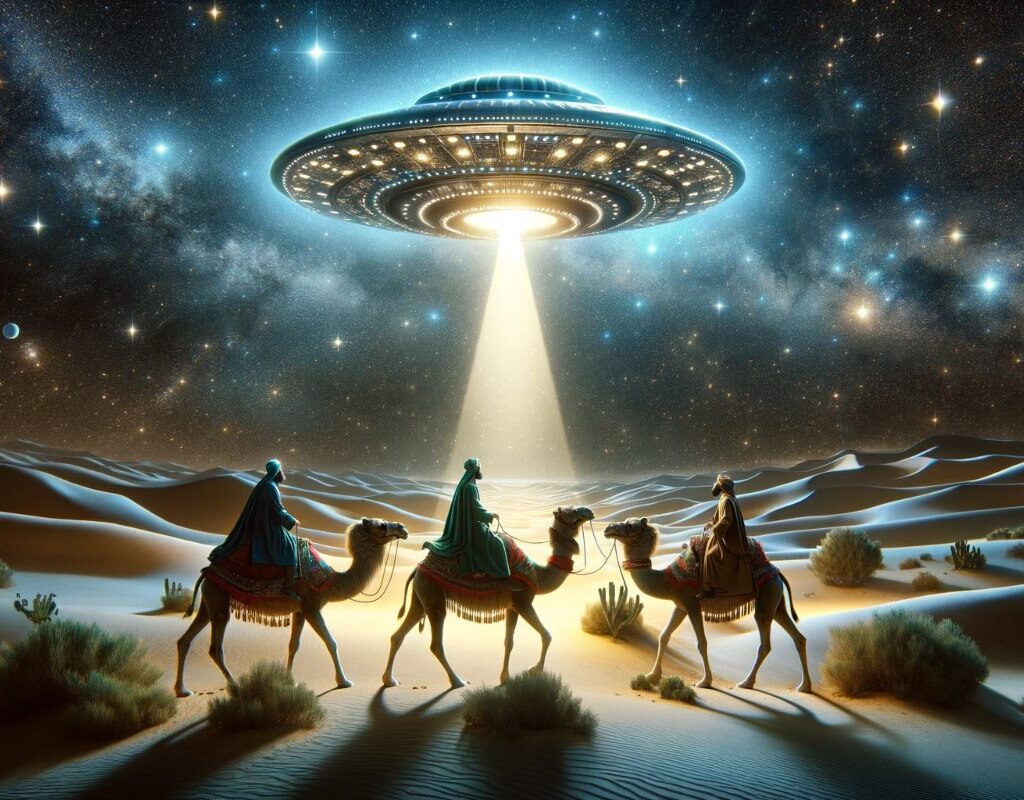Reinaldo Ríos’ hypothesis of a UFO guiding the Magi offers a fresh take on the traditional Christmas story. Blending mystical and scientific elements, this perspective challenges conventional interpretations and enriches our understanding of traditions, encouraging a reevaluation of established beliefs.
Magi and UFOs: An Extraterrestrial Christmas
Reinaldo Ríos’ interpretation of the Star of Bethlehem as an extraterrestrial spacecraft has garnered interest for its originality. He bases his perspective on the apocryphal gospels, ancient texts not part of the biblical canon but studied for their historical and spiritual content.
Ríos suggests these documents hold clues to the star’s true nature, hinting at a connection with extraterrestrial visitors.
This approach rejuvenates and challenges the traditional story, offering a vision that merges the mystical with the scientific. The hypothesis of a UFO leading the Magi not only adds a science fiction element to the narrative but also reflects an openness to broader interpretations of ancient texts.
Instead of adhering to a single explanation, this theory encourages a wider consideration of possibilities, even in stories deeply ingrained in our culture.
Ríos’ linkage of apocryphal tales with ufology exemplifies how new generations are reimagining traditions. His approach doesn’t aim to replace traditional interpretations but to expand the framework of understanding.
Considering previously unimaginable possibilities opens a dialogue between faith, history, and the potential for life beyond our planet. It’s a bold interpretation that invites us to rethink accepted notions, thus enriching our understanding of the past with modern perspectives.
Sendra: Lights in the Nativity Scene and Extraterrestrial Connections
The concept of “sendra,” a term in ufology referring to a tunnel of light from a UFO, finds an intriguing parallel in the Nativity story. The idea that a beam of light from the Star of Bethlehem might be a sendra opens a new dimension in interpreting this tradition. What has been viewed for centuries as a divine phenomenon could have alternative explanations in the realm of the extraterrestrial.
Ríos’ proposal to replace the star on the Christmas tree with a UFO representation is not just a creative idea; it reflects a mindset that seeks to integrate elements of popular culture and science fiction into traditions.
This blend of the ancient and the modern shows a desire to reinterpret and personalize celebrations, maintaining their essence while giving them a contemporary twist.
The depiction of angels in the Nativity scene as superior extraterrestrial beings adds even more depth to this theory. Exploring these possibilities opens new thought avenues about topics like extraterrestrial life and its potential interactions with humanity during pivotal moments in history.
Merging ufology with traditional tales not only enriches the debate about our origins and beliefs but also challenges established perceptions, inviting deeper reflection on the known and the unknown.
Between Faith and Science Fiction: New Interpretations of an Ancient Story
The theory linking the Magi to ufology represents more than a simple reinterpretation of an old tale. It reflects how traditional narratives can adapt and evolve in a world that constantly questions the boundaries of knowledge and faith.
Ríos’ hypothesis, viewing the Star of Bethlehem as a UFO, not only piques curiosity but also invites broader reflection on our beliefs and the realm of the unexplainable.
This modern approach to traditional stories demonstrates a fusion of the old and the new, a hallmark of contemporary society. By integrating ufological concepts into the Magi’s story, a space for dialogue emerges between different fields of knowledge, from theology to science fiction.
In conclusion, the proposition to reinterpret historical and religious events through the lens of ufology is more than an intriguing theory; it’s a testament to humanity’s quest to understand the world in broader and more varied terms.
By challenging conventional interpretations and opening the door to new possibilities, this perspective not only enriches our understanding of the past but also illuminates the path to a future where imagination and curiosity remain essential in shaping our world.





